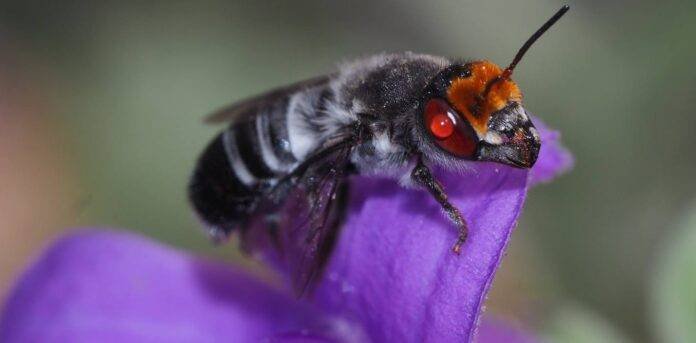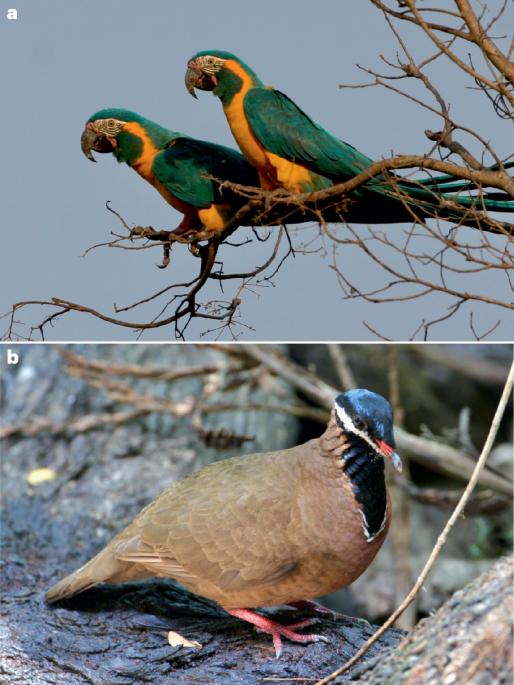Wagner, D. L. Insect declines in the anthropocene. Annu. Rev. Entomol. 65, 457–480 (2020).
Hallmann, C. A. et al. More than 75 percent decline over 27 years in total flying insect biomass in protected areas. PLoS ONE 12, e0185809 (2017).
van Klink, R. et al. Meta-analysis reveals declines in terrestrial but increases in freshwater insect abundances. Science 368, 417–420 (2020).
Salcido, D. M., Forister, M. L., Garcia Lopez, H. & Dyer, L. A. Loss of dominant caterpillar genera in a protected tropical forest. Sci. Rep. 10, 1–10 (2020).
Roubik, D. W. et al. Long-term (1979–2019) dynamics of protected orchid bees in Panama. Conserv. Sci. Pract. 3, e543 (2021).
Karban, R. & Huntzinger, M. Decline of meadow spittlebugs, a previously abundant insect, along the California coast. Ecology 99, 2614–2616 (2018).
Conrad, K. F., Warren, M. S., Fox, R., Parsons, M. S. & Woiwod, I. P. Rapid declines of common, widespread British moths provide evidence of an insect biodiversity crisis. Biol. Conserv. 132, 279–291 (2006).
van Klink, R. et al. Disproportionate declines of formerly abundant species underlie insect loss. Nature 628, 359–364 (2024).
Gaston, K. J. & Fuller, R. A. Biodiversity and extinction: losing the common and the widespread. Prog. Phys. Geogr. 31, 213–225 (2007).
Cardinale, B. J. et al. Biodiversity loss and its impact on humanity. Nature 489, 59–67 (2012).
van der Plas, F. Biodiversity and ecosystem functioning in naturally assembled communities. Biol. Rev. 94, 1220–1245 (2019).
Meyer, S. T. et al. Effects of biodiversity strengthen over time as ecosystem functioning declines at low and increases at high biodiversity. Ecosphere 7, e01619 (2016).
Winfree, R., Fox, J. W., Williams, N. M., Reilly, J. R. & Cariveau, D. P. Abundance of common species, not species richness, drives delivery of a real-world ecosystem service. Ecol. Lett. 18, 626–635 (2015).
Smith, M. D. & Knapp, A. K. Dominant species maintain ecosystem function with non-random species loss. Ecol. Lett. 6, 509–517 (2003).
Walker, B. et al. Plant attribute diversity, resilience and ecosystem function: the nature and significance of dominant and minor species. Ecosystems 2, 95–113 (1999).
Laliberté, E. et al. Land-use intensification reduces functional redundancy and response diversity in plant communities. Ecol. Lett. 13, 76–86 (2010).
Petchey, O. L. & Gaston, K. J. Functional diversity (FD), species richness and community composition. Ecol. Lett. 5, 402–411 (2002).
Weigelt, A. et al. The Jena Experiment: six years of data from a grassland biodiversity experiment. Ecology 91, 930–931 (2010).
Tilman, D. et al. Diversity and productivity in a long-term grassland experiment. Science 294, 843–845 (2001).
Eisenhauer, N. et al. A multitrophic perspective on biodiversity–ecosystem functioning research. Adv. Ecol. Res. 61, 1–54 (2019).
Hu, W. et al. Aridity-driven shift in biodiversity–soil multifunctionality relationships. Nat. Commun. 12, 5350 (2021).
Schuldt, A. et al. Biodiversity across trophic levels drives multifunctionality in highly diverse forests. Nat. Commun. 9, 2989 (2018).
Lefcheck, J. S. et al. Biodiversity enhances ecosystem multifunctionality across trophic levels and habitats. Nat. Commun. 6, 6936 (2015).
Gamfeldt, L., Hillebrand, H. & Jonsson, P. R. Multiple functions increase the importance of biodiversity for overall ecosystem functioning. Ecology 89, 1223–1231 (2008).
Zavaleta, E. S., Pasari, J. R., Hulvey, K. B. & Tilman, D. Sustaining multiple ecosystem functions in grassland communities requires higher biodiversity. Proc. Natl Acad. Sci. USA 107, 1443–1446 (2010).
Mori, A. S. et al. Low multifunctional redundancy of soil fungal diversity at multiple scales. Ecol. Lett. 19, 249–259 (2015).
Diaz, S., Symstad, A. J., Chapin, F. S., Wardle, D. A. & Huenneke, L. F. Functional diversity revealed by removal experiments. Trends Ecol. Evol. 18, 140–146 (2003).
Andersen, A. N. & Patel, A. D. Meat ants as dominant members of Australian ant communities: an experimental test of their influence on the foraging success and forager abundance of other species. Oecologia 98, 15–24 (1994).
Gibb, H. & Hochuli, D. F. Removal experiment reveals limited effects of a behaviorally dominant species on ant assemblages. Ecology 85, 648–657 (2004).
Majer, J. D. The maintenance of the ant mosaic in ghana cocoa farms. J. Appl. Ecol. 13, 123–144 (1976).
King, J. R. & Tschinkel, W. R. Experimental evidence that the introduced fire ant, Solenopsis invicta, does not competitively suppress co-occurring ants in a disturbed habitat. J. Anim. Ecol. 75, 1370–1378 (2006).
Wardle, D. A. et al. Long-term aboveground and belowground consequences of red wood ant exclusion in boreal forest. Ecology 92, 645–656 (2011).
Zelikova, T. J., Sanders, N. J. & Dunn, R. R. The mixed effects of experimental ant removal on seedling distribution, belowground invertebrates, and soil nutrients. Ecosphere 2, art63 (2011).
Parr, C. L., Eggleton, P., Davies, A. B., Evans, T. A. & Holdsworth, S. Suppression of savanna ants alters invertebrate composition and influences key ecosystem processes. Ecology 97, 1611–1617 (2016).
Verheyen, K. et al. Contributions of a global network of tree diversity experiments to sustainable forest plantations. Ambio 45, 29 (2015).
Perring, M. P. et al. The Ridgefield Multiple Ecosystem Services Experiment: can restoration of former agricultural land achieve multiple outcomes? Agric. Ecosyst. Environ. 163, 14–27 (2012).
Kluge, J. & Kessler, M. Phylogenetic diversity, trait diversity and niches: species assembly of ferns along a tropical elevational gradient. J. Biogeogr. 38, 394–405 (2011).
Farias, A. A. & Jaksic, F. M. Low functional richness and redundancy of a predator assemblage in native forest fragments of Chiloe Island, Chile. J. Anim. Ecol. 80, 809–817 (2011).
Bihn, J. H., Gebauer, G. & Brandl, R. Loss of functional diversity of ant assemblages in secondary tropical forests. Ecology 91, 782–792 (2010).
Gerisch, M., Agostinelli, V., Henle, K. & Dziock, F. More species, but all do the same: contrasting effects of flood disturbance on ground beetle functional and species diversity. Oikos 121, 508–515 (2012).
Petchey, O. L., Evans, K. L., Fishburn, I. S. & Gaston, K. J. Low functional diversity and no redundancy in British avian assemblages. J. Anim. Ecol. 76, 977–985 (2007).
Weiher, E. & Keddy, P. A. Assembly rules, null models, and trait dispersion: new questions from old patterns. Oikos 74, 159–164 (1995).
Perkins, D. M. et al. Higher biodiversity is required to sustain multiple ecosystem processes across temperature regimes. Glob. Change Biol. 21, 396–406 (2015).
Loreau, M. et al. Biodiversity and ecosystem functioning: current knowledge and future challenges. Science 294, 804–808 (2001).
Wardle, D. A. Is ‘sampling effect’ a problem for experiments investigating biodiversity-ecosystem function relationships? Oikos 87, 403–407 (1999).
Mori, A. S., Furukawa, T. & Sasaki, T. Response diversity determines the resilience of ecosystems to environmental change. Biol. Rev. 88, 349–364 (2013).
Loreau, M. Does functional redundancy exist? Oikos 104, 606–611 (2004).
Houadria, M. & Menzel, F. What determines the importance of a species for ecosystem processes? Insights from tropical ant assemblages. Oecologia 184, 885–899 (2017).
Dı́az, S. & Cabido, M. Vive la différence: plant functional diversity matters to ecosystem processes. Trends Ecol. Evol. 16, 646–655 (2001).
Wardle, D. A. Do experiments exploring plant diversity-ecosystem functioning relationships inform how biodiversity loss impacts natural ecosystems? J. Veg. Sci. 27, 646–653 (2016).
Yeeles, P., Lach, L., Hobbs, R. J., van Wees, M. & Didham, R. K. Woody plant richness does not influence invertebrate community reassembly trajectories in a tree diversity experiment. Ecology 98, 500–11 (2017).
Parr, C. L. et al. GlobalAnts: a new database on the geography of ant traits (Hymenoptera: Formicidae). Insect Conserv. Divers. 10, 5–20 (2016).
Laliberté, E. & Legendre, P. A distance-based framework for measuring functional diversity from multiple traits. Ecology 91, 299–305 (2010).
Gibb, H. & Johansson, T. Field tests of interspecific competition in ant assemblages: revisiting the dominant red wood ants. J. Anim. Ecol. 80, 548–557 (2011).
Greenslade, P. J. M. Sampling ants with pitfall traps: digging-in effects. Insectes Soc. 20, 343–353 (1973).
Wang, X. G., Johnson, M. W., Opp, S. B., Krugner, R. & Daane, K. M. Honeydew and insecticide bait as competing food resources for a fruit fly and common natural enemies in the olive agroecosystem. Entomol. Exp. Appl. 139, 128–137 (2011).
Byrnes, J. E. K., Roger, F. & Bagchi, R. Understandable multifunctionality measures using Hill numbers. Oikos 2023, e09402 (2023).
Jing, X. et al. Variation in the methods leads to variation in the interpretation of biodiversity-ecosystem multifunctionality relationships. J. Plant Ecol. 13, 431–441 (2020).
Byrnes, J. E. K. et al. Investigating the relationship between biodiversity and ecosystem multifunctionality: challenges and solutions. Methods Ecol. Evol. 5, 111–124 (2014).
Bates, D., Mächler, M., Bolker, B. & Walker, S. Fitting linear mixed-effects models using lme4. J. Stat. Softw. 67, 1–48 (2015).
R Core Team. R: A Language and Environment for Statistical Computing (R Foundation for Statistical Computing, 2021).
Jost, L. Entropy and diversity. Oikos 113, 363–375 (2006).
Chase, J. M. & Knight, T. M. Scale-dependent effect sizes of ecological drivers on biodiversity: why standardised sampling is not enough. Ecol. Lett. 16, 17–26 (2013).
Chase, J. M., Kraft, N. J. B., Smith, K. G., Vellend, M. & Inouye, B. D. Using null models to disentangle variation in community dissimilarity from variation in α-diversity. Ecosphere 2, art24 (2011).
Wood, S. Generalized Additive Models: An Introduction with R (Chapman and Hall, 2017).
Mazerolle, M. J. AICcmodavg: model selection and multimodel inference based on (Q)AIC(c). R package v.2.3.3 https://cran.r-oject.org/package=AICcmodavg (2023).
Lefcheck, J. S. piecewiseSEM: piecewise structural equation modelling in R for ecology, evolution, and systematics. Methods Ecol. Evol. 7, 573–579 (2016).
Gotelli, N. J., Ulrich, W. & Maestre, F. T. Randomization tests for quantifying species importance to ecosystem function. Methods Ecol. Evol. 2, 634–642 (2011).
Ulrich, W. Impact—a FORTRAN program for gradient analysis: version 1.0. (2010); www.home.umk.pl/~ulrichw/Downloads/ImpactManual.pdf
Yeeles, P., Lach, L., Hobbs, R. J., & Didham, R. K. D. Data from: functional redundancy compensates for decline of dominant ant species. figshare https://doi.org/10.6084/m9.figshare.27998150 (2025).






